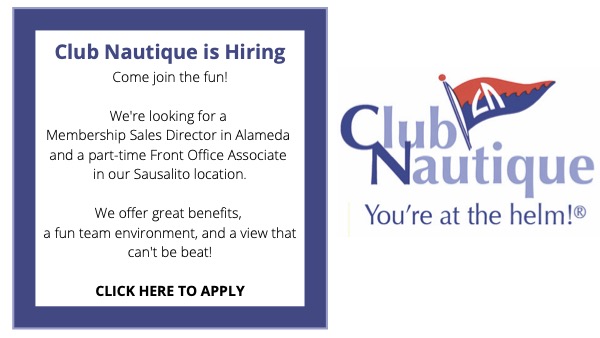
Alameda’s ‘Round the Island Cruise Makes a Comeback
A new year means another ‘Round the Island cruise — and a return to Alameda’s tradition of open yacht club hospitality on New Year’s Day.
Rounding
On January 1, 2022, dozens of boats launched into the Oakland-Alameda Estuary in the early hours, keen to ride the tide under Alameda’s four bridges, into Aeolian Yacht Club for a Bloody Mary, then out the San Leandro Channel to complete the circumnavigation. No ‘Round the Island is complete without visits to as many of Alameda’s boating venues as you can handle. In 2022, Aeolian, Ballena Bay and Encinal YCs welcomed us.
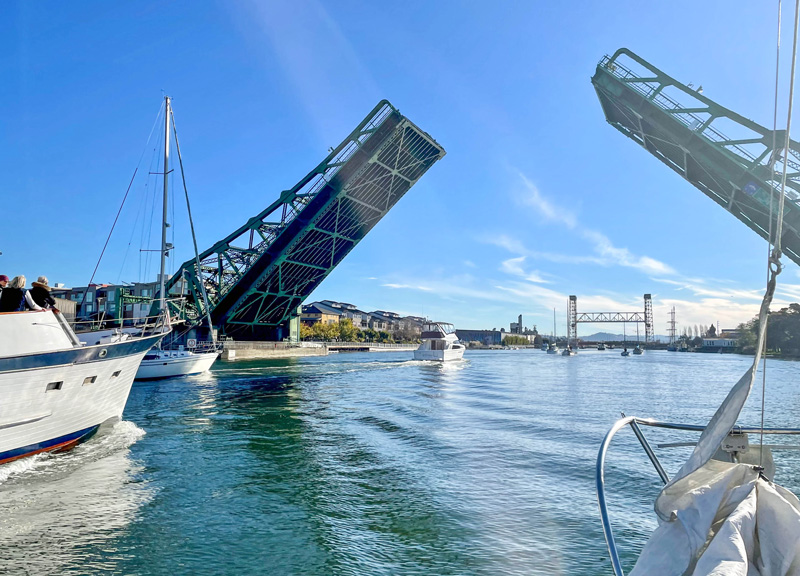
While the opening of the bridges is the highlight for many cruisers, it was evident that after 2021’s pandemic-related club closures, both clubs and boaters were thrilled to return to some kind of normal. This year’s ‘Round the Island dining included chili, hot dogs and cocktails at Aeolian Yacht Club, gumbo soup with cornbread at Encinal Yacht Club, and open doors and libations at Ballena Yacht Club, which hosted boaters for the first time after closure throughout most of 2021. Island Yacht Club presented boaters with commemorative certificates, “suitable for framing and surely a family heirloom,” as described jokingly by IYC vice commodore Eric Korbas.
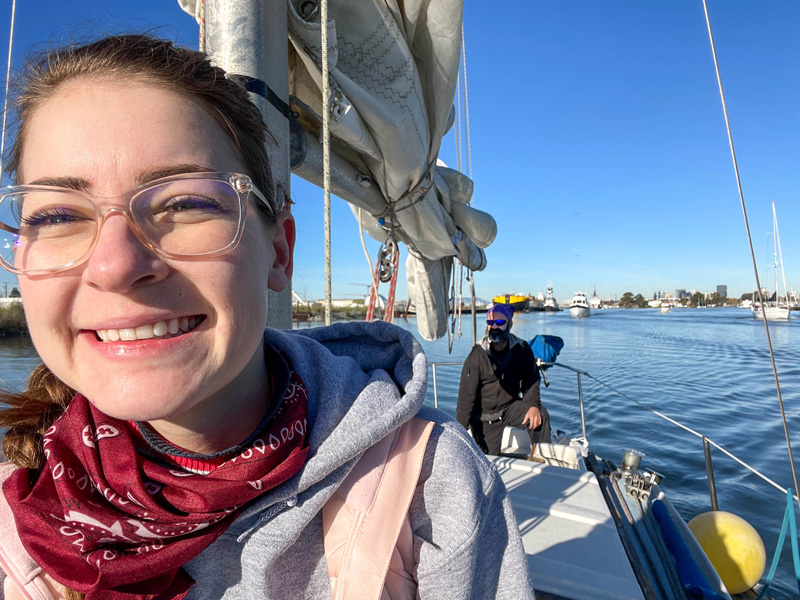
Each participating yacht club coordinates its own flotilla, as do class fleets such as the Islander 36 Association, to ensure their contingents stick together for the bridge openings, club cruise-ins, and the perilous transit of San Leandro Bay. Island YC’s flotilla had a riot of a time, with Eric Korbas sharing the following account:
“I can’t personally think of a way that the 2022 ‘Round the Island could have gone any better. In the first outbound flotilla at 9:30, I counted 13 boats. Numerous other boats made it out a bit later — perhaps delayed by a little too much New Year’s fun! It was a bit of dodgeball with logs in the water, but we had great weather, hardly a cloud in the sky. Although initially cold (there was actual ice on the docks), the glorious sun came out. It warmed us up nicely.
“This reminds me of just how pretty a place we are lucky enough to live in. Every one of the yacht clubs was so welcoming and fantastic hosts for the fun. Be it helping with coordinating docking and a friendly welcome and lay of the land, to the great food and drinks, we want to say a big thank you to Aeolian, Ballena Bay and Encinal Yacht Clubs for the wonderful hospitality.”
From Kathie Boothby, vice commodore of Aeolian YC, who did a fabulous job coordinating the clubs: “What a fun event! We had more than 50 boats come into our harbor during the day. Folks were smiling and happy as the gin fizzes flowed.”
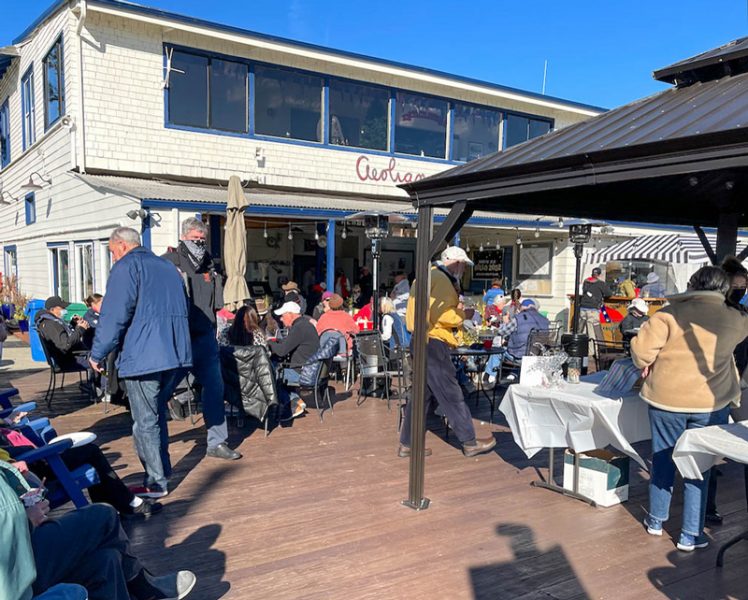
Sadly, not every boat made it around Alameda Island in a timely fashion. Just south of the Bay Farm Bridge, the San Leandro channel is a challenging leg, even for experienced boaters. With the channel’s mean low being 2 feet and navigation markers that consist of PVC tubing stuck into the mud, many a keelboat has found itself trapped under Oakland Airport’s flight path, waiting for the tide to rise.
Grounding
Peter Wolfe’s Olson 25 Out of Control found itself in channel peril this year. Thankfully, mutual aid was close at hand. Santana 22 owner Hank Lindemann offered assistance in rescuing both boat and crew. Peter shared:
“Thank you to Hank for his help in getting the ladies off the boat and home yesterday, and for words of wisdom and actions to try and get Out of Control out of the mud. I got lifted at 10:55 p.m., set a course, and got back to Fortman Marina at 3 a.m. The motor kept jiggling off its mounts, which had a lock on, for which I didn’t have the key with me. So I half-throttled home with one foot on the motor mounts, to keep them from flying free. Happy New Year! It’s got to get better than Day 1.”
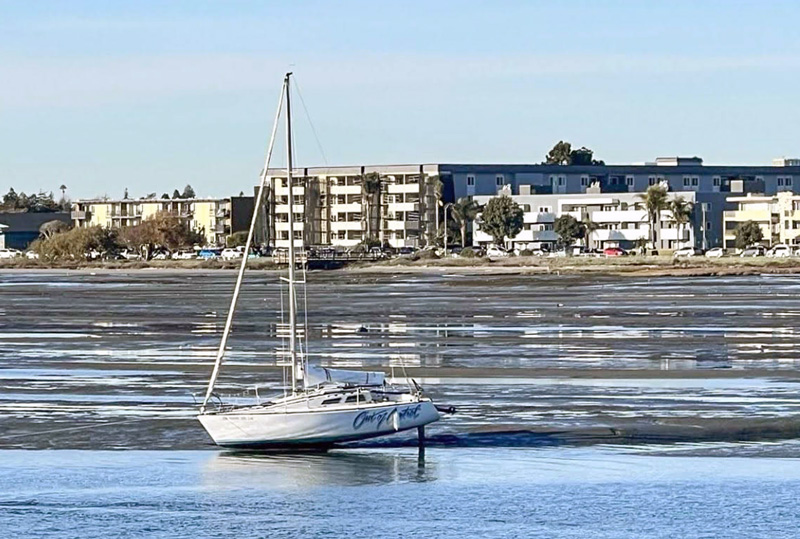
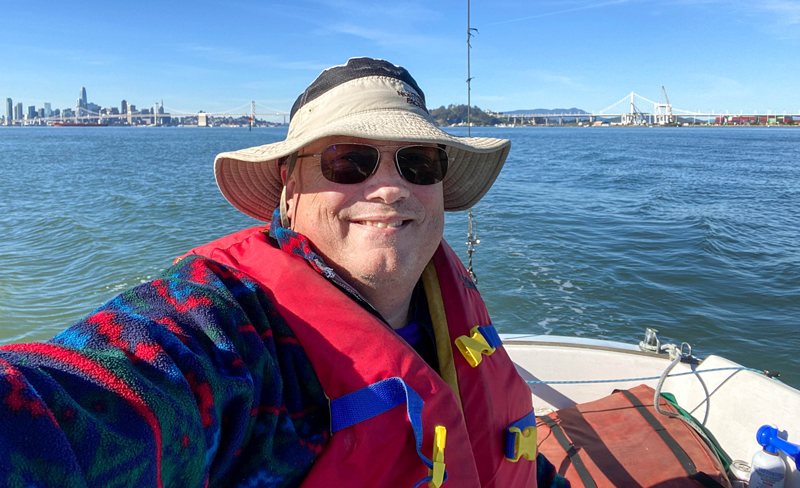
The clubs have already started discussing another circumnavigation cruise, likely in the summer, when the weather is warm and Alameda Estuary boating activity is at its peak. Until then, may Peter Wolfe’s greeting ring true for all San Francisco Bay Area boaters in 2022: We all hope it only gets better from here!
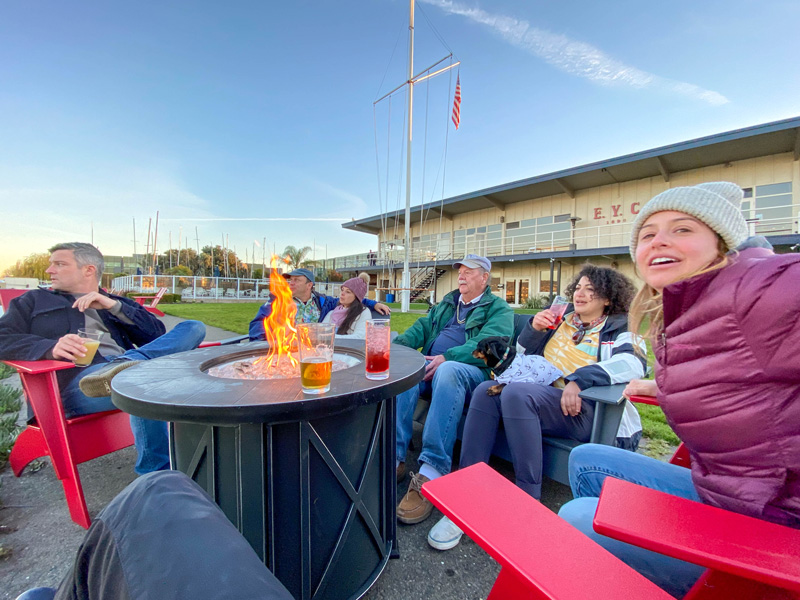
Good Jibes #21: Rich Jepsen on Teaching Others How to Sail
Welcome to the first Good Jibes episode for 2022! This week’s host, John Arndt, is joined by Rich Jepsen to chat about his lifetime of sailing instructing and racing, and US Sailing. Rich is the president of US Sailing and has spent 34 years as managing partner of OCSC Sailing, a commercial sailing school and club. He’s been sailing since he was a child, has spent multiple decades on numerous sailing committees, and has served three separate stints on the US Sailing Board of Directors. Hear how to become a sailing instructor and encourage others to get into sailing, about the changing demographics of sailing, how to make sailing cost-effective, and about the benefits you get as a US Sailing member.
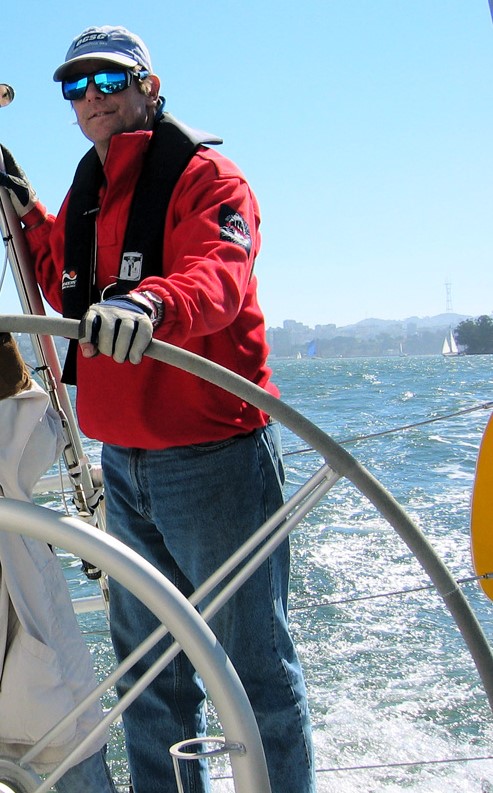
This episode covers everything from teaching sailing to family sailing trips. Here’s a small sample of what you will hear in this episode:
- How has Rich’s teaching approach changed over time?
- What kind of sailing did they do as a family?
- How did Rich get into sailing as a career?
- Why would he encourage others to be sailing instructors?
- What got him hooked at US Sailing?
- How do you get people into sailing?
- What are the next steps for US Sailing?
- Short Tacks: West Coast vs. East Coast sailing?
Learn more at https://www.latitude38.com/lectronic/san-francisco-bay-sailor-rich-jepsen-takes-helm-us-sailing/.
Listen to the episode on Apple Podcasts, Spotify, Google Podcasts, and your other favorite podcast spots – follow and leave a 5-star review if you’re feeling the Good Jibes!
Club Nautique Is Hiring Sales and Office Staff
Why Is Sailing Like Reading Latitude 38?
What’s the greatest escape on the planet? Sailing. When contributing editor Ross Tibbits interviewed Roy Disney for our recent Good Jibes podcast and asked why a powerboater would want to consider sailing, Roy responded, “When we turn the motor off, and any sailor will tell you this, there’s a sudden calmness and peacefulness that happens when you just hear the sound of the ocean passing by. And the boat tips over, which is fine. It’s designed to do that. And now you’re relying entirely on your instincts and your awareness of your environment and everything around you and the subtleties of change, which happens, you know, 100 times a second. And it’s all you. It’s such a communion of nature, and physics and beauty and design and your own effort.”
When we produce Latitude 38, we try to capture the same feeling of escape, fun, calmness, engagement and peacefulness that comes with sailing. We were thinking about this when we walked into Barnes & Noble to find a book, and passed by the magazine rack — it was packed with great reads. This reminded us that, despite our device-based life, there is a more comfortable way to engage with the torrent of information in the world. Shutting down your devices and picking up a magazine feels like the moment you turn the engine off.
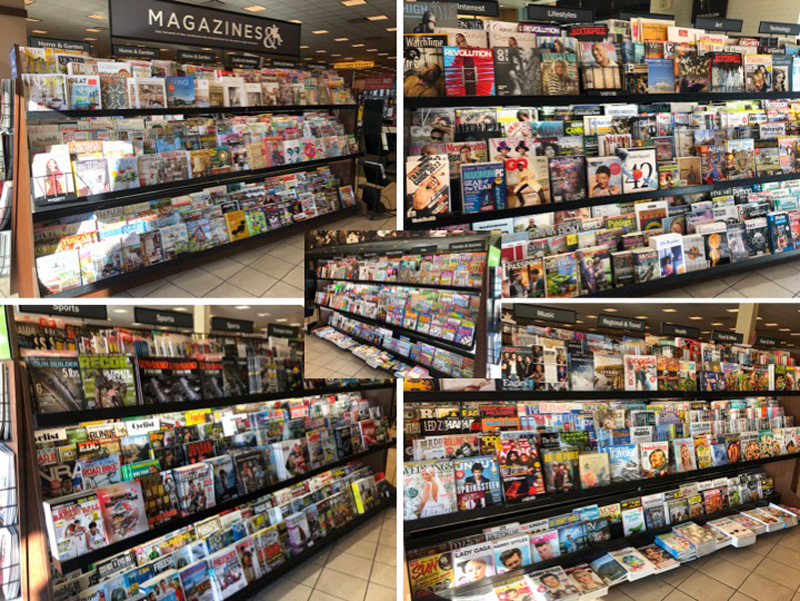
Another reminder of why we like reading ‘unplugged’ was Latitude 38 contributor and podcast instigator Ryan Foland’s recent Twitter photo that he posted as he started the new year. Ryan is a digital native with active social media, podcast and Twitter channels. Yet he and his wife Cynthia like to escape on their Cal 34 Bingo, and enjoy some quiet time with a paper. Ryan’s January 1 Twitter comment with the photo was, “Current Mood = In no hurry to do anything. I feel like I’ve got a full year ahead of me.”
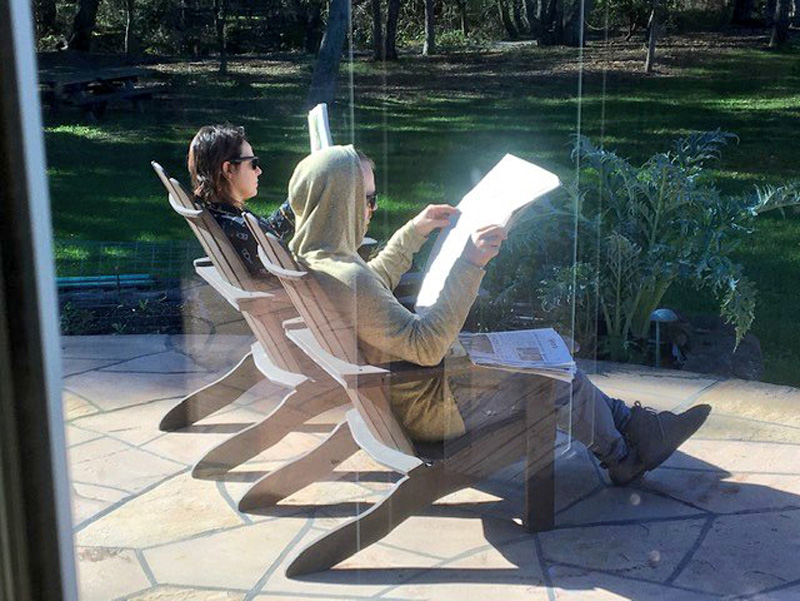
Yes, we get the irony of posting this story for you to read on our active ‘Lectronic Latitude page, but we feel it’s our duty to remind everyone (including ourselves) to take a break to go sailing, or unwind with an undistracted read. Both will help you cruise through the new year with more ease, adventure and enjoyment.
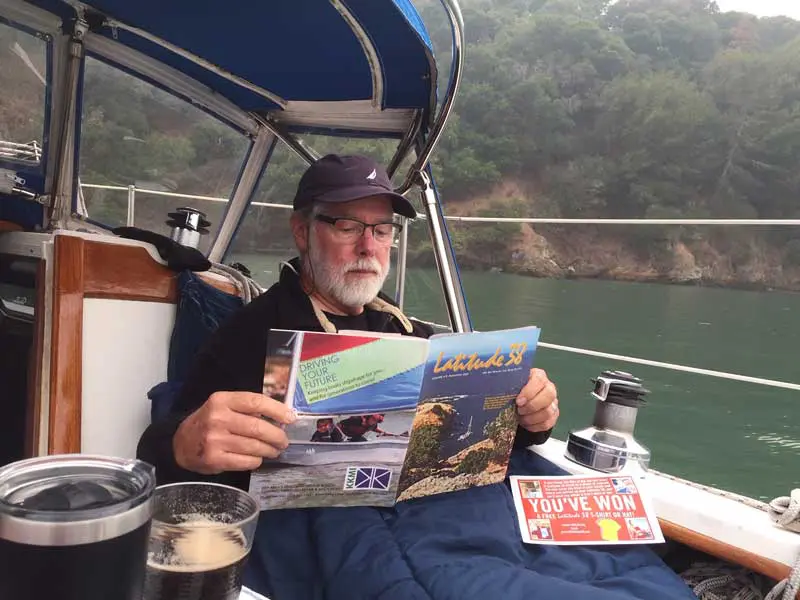
We think picking up a magazine, newspaper or book is a healthy digital detox and makes for an excellent New Year’s resolution. Of course, it doesn’t match the escape of sailing itself, but we do our best to provide just enough humor, fun, adventure and inspiration that you’ll have a moment of escape wherever you are. If that sounds good, make sure, on your next visit to your boat, that you swing by the marina office to pick up a free copy and say hello and happy New Year to your friendly harbormaster. Or find a copy at any of these other locations.
The Resourceful Sailor: Building Transparent Drop Boards
Have you ever been tucked cozily below and wished you could see astern? Or had more daylight shining belowdecks? Sampaguita, a 1985 Pacific Seacraft Flicka 20, has three companionway drop boards made from 3/4-inch teak. They have stood the test of time but make the cold, dark winters darker. What if there were transparent drop boards as an alternative? This installment of The Resourceful Sailor explores what he came up with for Sampaguita.
I knew I wanted to make at least one clear plastic drop board. I thought through a few design and material ideas, deciding the best approach was the simplest, mimicking the dimensions of one of the upper two of three factory drop boards. The criteria were low weight and cost, water resistance on par with the factory boards, no rattling, and of course, see-through. The intention was not to permanently replace the present drop boards but to offer options depending on the weather and situation.
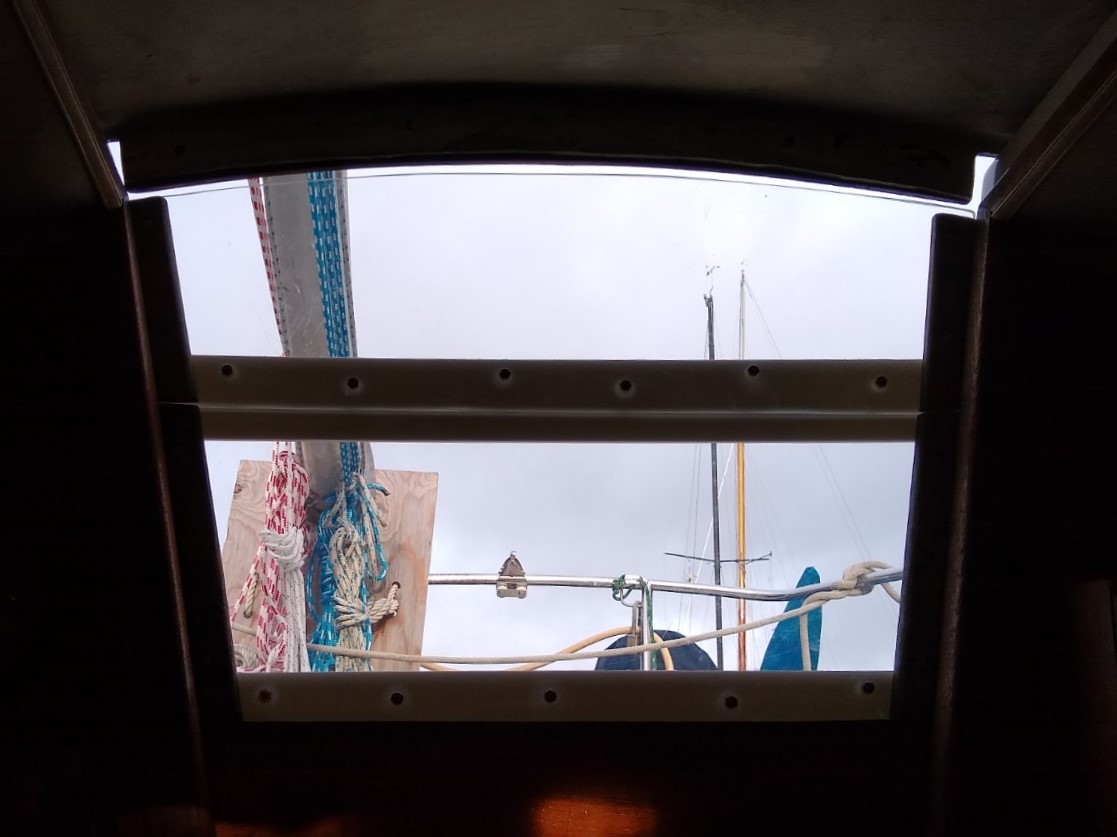
Acrylic (Plexiglass) or polycarbonate (Lexan) seemed like the go-to options when selecting the board material. Presently, both of these can be tricky to source due to supply chain issues and demand. While polycarbonate is the stronger, I decided on acrylic because it is more scratch-resistant and costs less. As for the type of acrylic, I prefer cast to extruded because of its hardness, and because it machines more cleanly.
However, a friend settled any debate when he offered me a piece of acrylic with an unknown heritage that was right-sized for the job. It was large enough to make both of the upper drop boards. At only 1/4 inch thick, it meant trim was necessary to fit the companionway slots, which were 7/8 inch wide, but it would also save considerable weight.
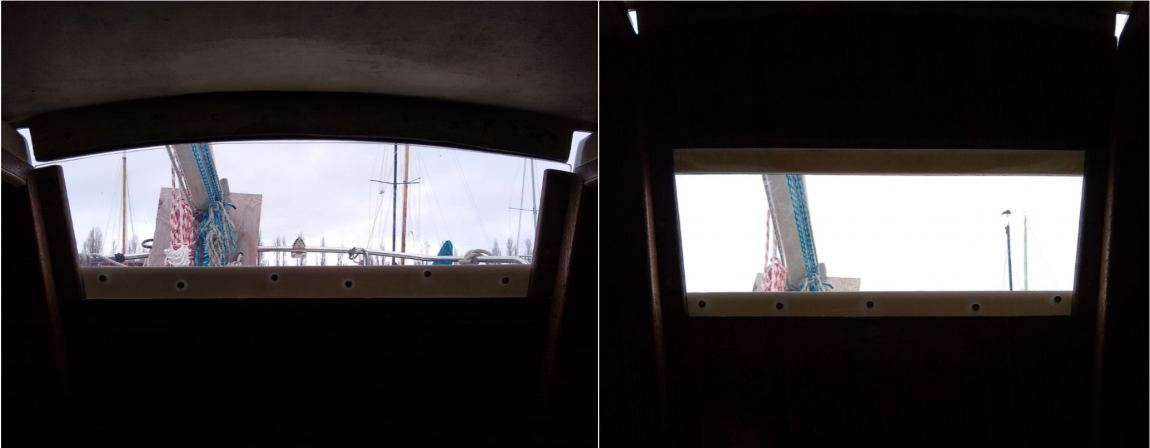
I traced the shapes of the top two companionway boards on the acrylic, mostly straight edges, and used a table saw with a fence rail to make straight cuts. The one curved side I cut with a jigsaw. I smoothed out the rough edges with sandpaper.
The trim came from my old teak bow platform that I replaced and Starboard remnants from a different project. While the teak had some rot, there was enough good wood to cut four 1/2-inch-thick strips to fasten to the short sides of each acrylic board. The widths were just right, and already had rounded edges. Convenient. In addition to being spacers, they added rigidity. Again, a table saw worked nicely for making smart cuts.
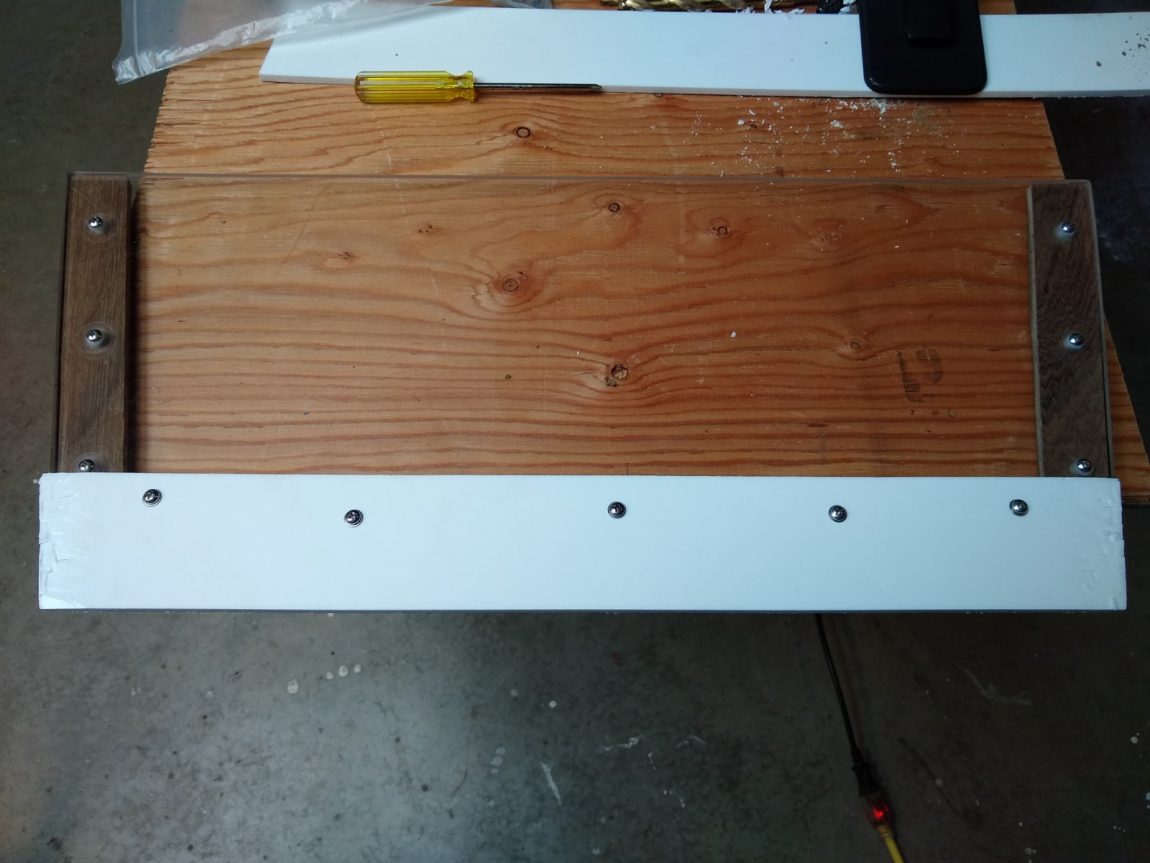
I cut long, three-inch strips of 1/4-inch Starboard to fit the bottom length of each acrylic board. These would act as an additional spacer and overlapping lip to the board below, mitigating the water coming through the cracks.
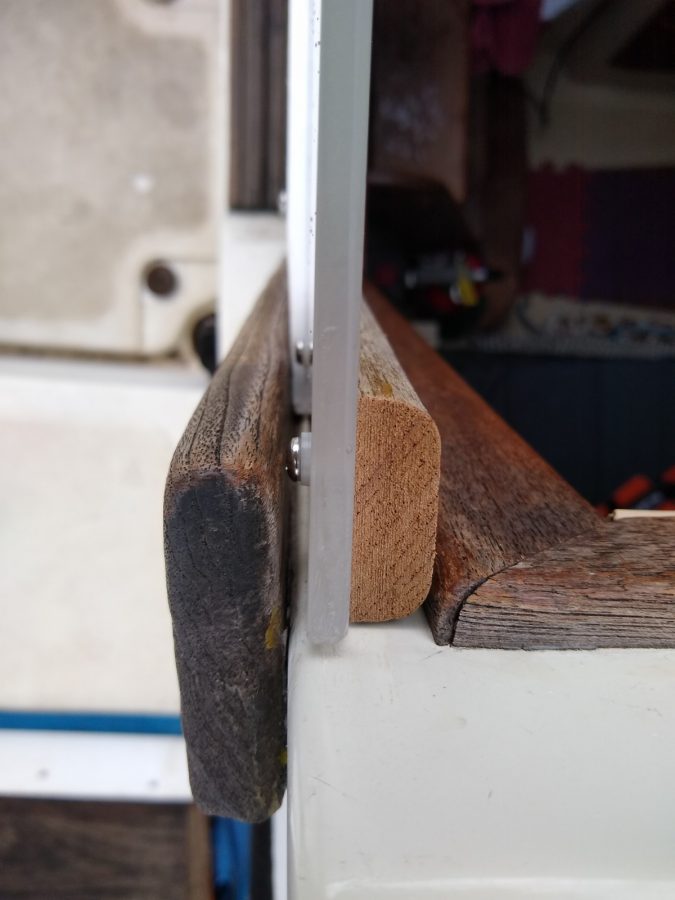
I drilled holes in the acrylic, teak, and Starboard and fastened them together with #8 pan head stainless steel machine screws and nuts. I selected screw lengths to be as short as possible to minimize protrusion. I counterbored holes in the teak trim, so the nuts and screw ends sat below its surface. I anticipated these would be the worst offenders for snagging and gouging their surroundings. Once all this was assembled, I sanded the Starboard down on the ends a little to achieve a snug fit in the slots.
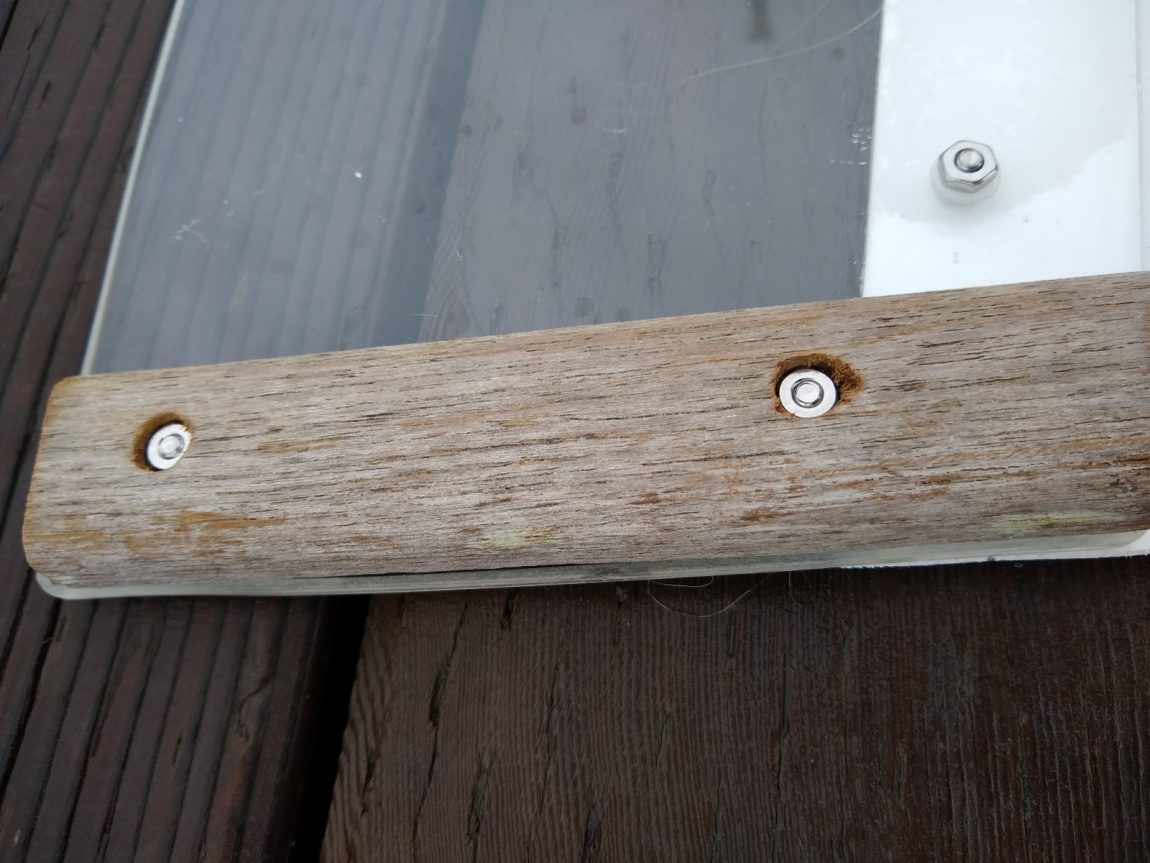
Besides measuring and getting things square, there are tools and techniques for machining acrylic to mitigate chipping and melting. I highly recommend buying a drill bit designed for plastic and reading what the experts say about how best to use it. It is an article in itself. Then practice with some scraps to get a feel for working with it. The acrylic wants to chip when you cut and drill it. Every chip likely means a crack, even if it is too small to see. Rest assured, these cracks will migrate over time.
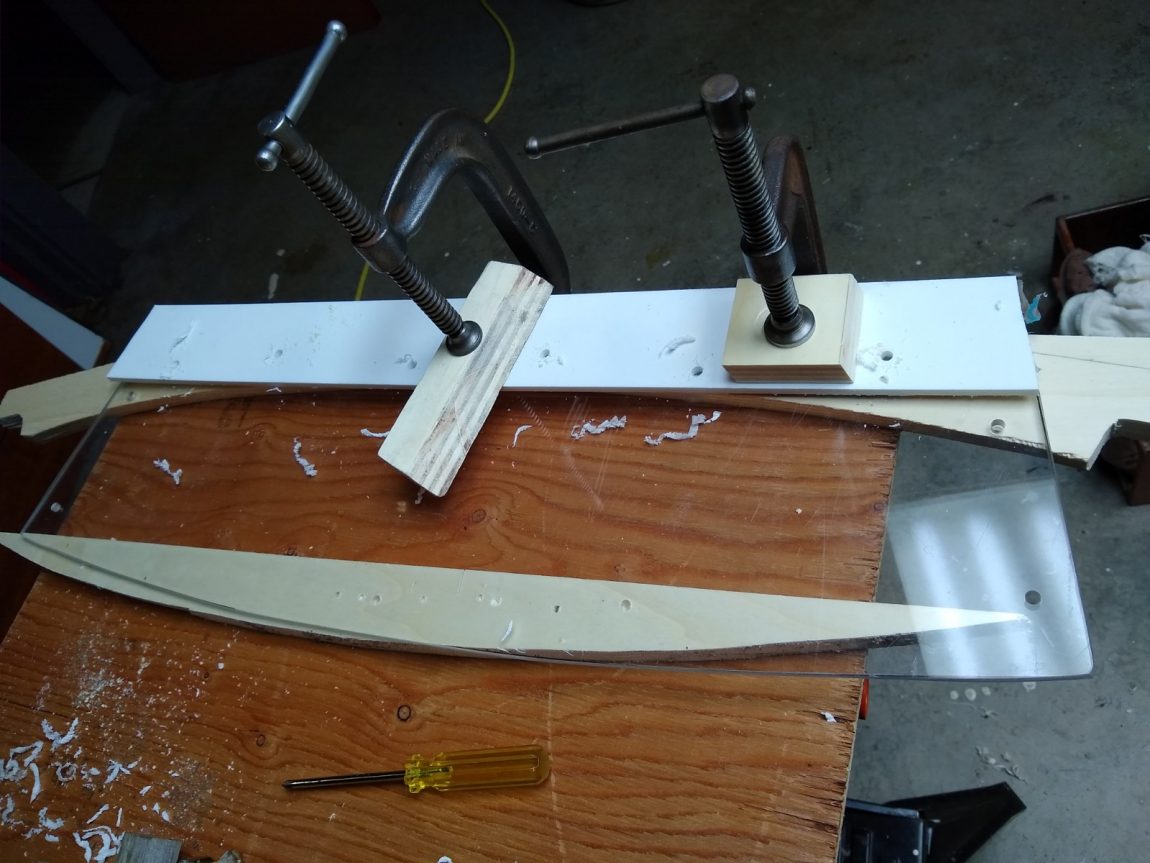
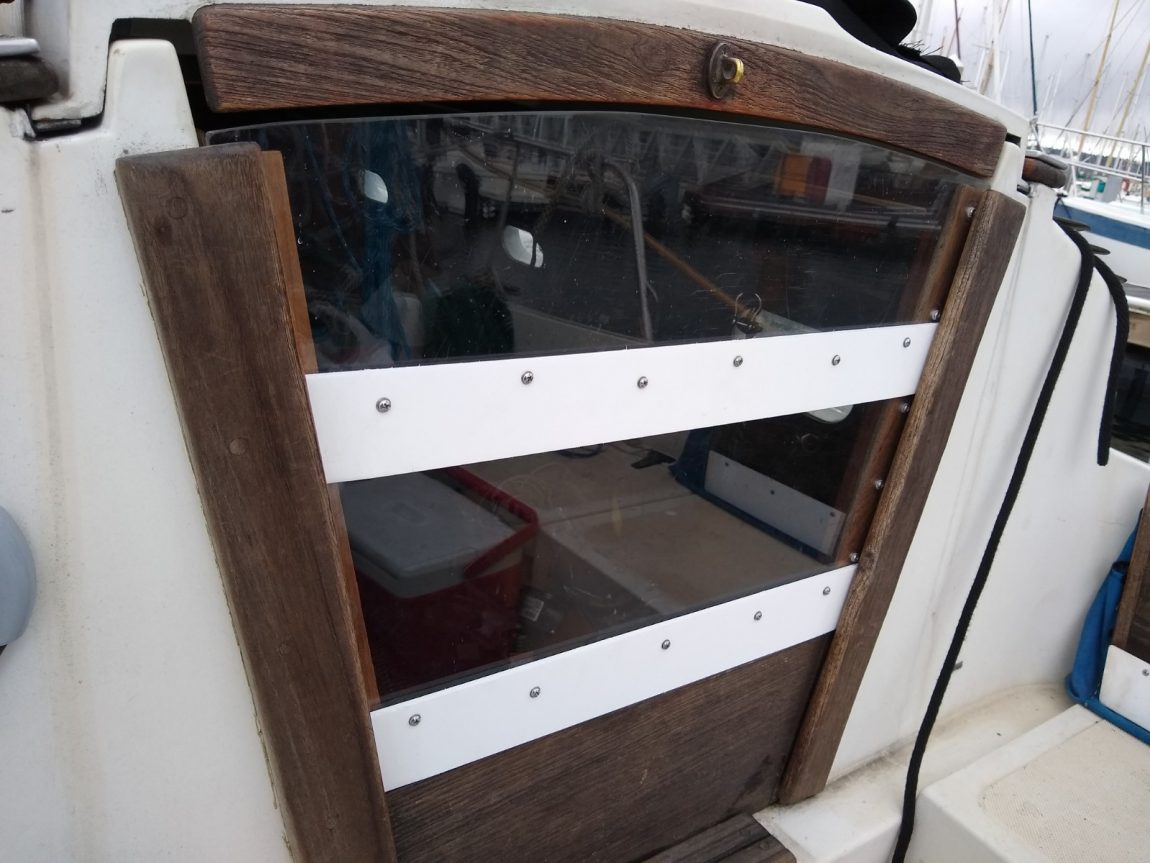
The Resourceful Sailor used gifted, leftover, and repurposed materials in a way that fit the criteria for Sampaguita. While creating the boards from solid pieces of thick acrylic would have reduced the drilling, at 3/4-7/8 inch thick, they would be both heavy and expensive. The thinner acrylic determined the choice of pan head screws over flat head countersunk ones to avoid extra machining likely to compromise the material over time. Starboard lips were previously attached to the factory drop boards to mitigate water ingress, so there was experience as well as remnants. Remember, keep your solutions prudent and safe, and have a blast.
Want to see more from The Resourceful Sailor? Here’s a previous article we published: Chafe Is Your Enemy.

